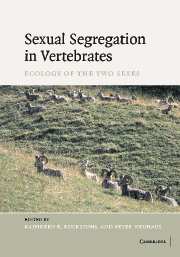Book contents
- Frontmatter
- Contents
- List of contributors
- Preface
- Part I Overview
- Part II Concepts and methodology
- Part III Foraging ecology
- Part IV Predator avoidance and reproductive strategies
- Part V Sex-related activities and social factors
- Part VI Sexual differences in ecology: comparisons within different taxa
- 13 Ecological divergence between the sexes in reptiles
- 14 Sexual segregation in Australian marsupials
- 15 Social systems and ecology of bats
- 16 Sociality and ecology of the odontocetes
- 17 Sexual segregation in non-human primates
- Part VII Implications for conservation
- Part VIII Outlook
- References
- Index
14 - Sexual segregation in Australian marsupials
Published online by Cambridge University Press: 04 September 2009
- Frontmatter
- Contents
- List of contributors
- Preface
- Part I Overview
- Part II Concepts and methodology
- Part III Foraging ecology
- Part IV Predator avoidance and reproductive strategies
- Part V Sex-related activities and social factors
- Part VI Sexual differences in ecology: comparisons within different taxa
- 13 Ecological divergence between the sexes in reptiles
- 14 Sexual segregation in Australian marsupials
- 15 Social systems and ecology of bats
- 16 Sociality and ecology of the odontocetes
- 17 Sexual segregation in non-human primates
- Part VII Implications for conservation
- Part VIII Outlook
- References
- Index
Summary
OVERVIEW
Most research on sexual segregation has been focused on eutherian mammals, showing that this phenomenon is widely but unevenly distributed across eutherian taxa, and is particularly prevalent amongst ungulate species that are sexually dimorphic in body size and give birth highly synchronously. Marsupials comprise a clade of mammals that has undergone extensive radiation in parallel to that of eutherians in terms of morphology, ecology and behaviour. We would then expect sexual segregation to occur in some marsupials, as it does in some eutherians, and most likely in those marsupial species that exhibit sexual dimorphism in body size and give birth highly synchronously.
We reviewed the literature for evidence of sexual segregation in 23 species from three orders of extant Australian marsupials. These species were drawn from each family and sub-family within these orders, and from distinct life-history categories within one family. We collated the incidence and form of segregation, the degree of body size dimorphism and the degree of birth synchrony in each species. We predicted that if dimorphism and synchrony were associated with sexual segregation in marsupials, then segregation should occur predominantly in species that were dimorphic and/or highly synchronous, but not in species that were monomorphic and gave birth year-round. We also reviewed, in greater detail, the occurrence of sexual segregation in the genus Macropus, comprising the kangaroos and larger wallabies, since they are ecologically and behaviourally comparable to many ungulates.
- Type
- Chapter
- Information
- Sexual Segregation in Vertebrates , pp. 254 - 279Publisher: Cambridge University PressPrint publication year: 2006
- 2
- Cited by



